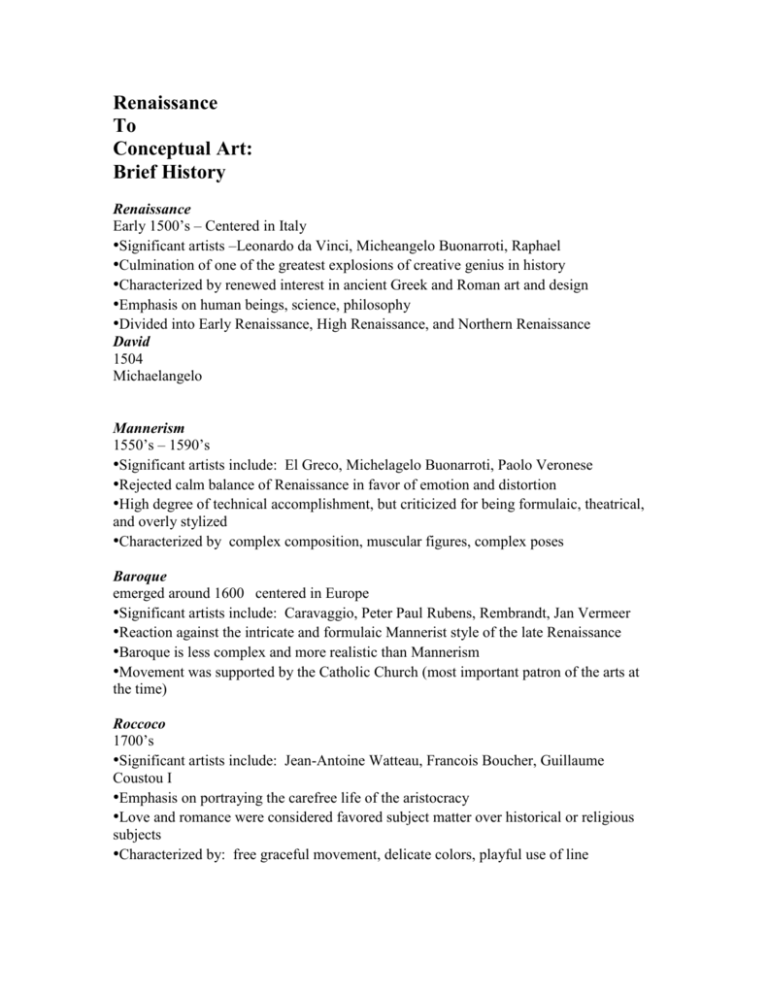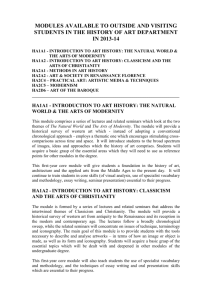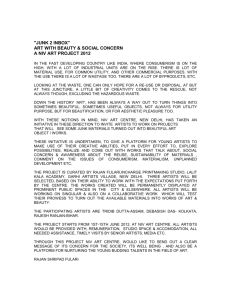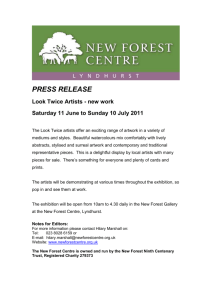art movements ,brief history
advertisement

Renaissance To Conceptual Art: Brief History Renaissance Early 1500’s – Centered in Italy •Significant artists –Leonardo da Vinci, Micheangelo Buonarroti, Raphael •Culmination of one of the greatest explosions of creative genius in history •Characterized by renewed interest in ancient Greek and Roman art and design •Emphasis on human beings, science, philosophy •Divided into Early Renaissance, High Renaissance, and Northern Renaissance David 1504 Michaelangelo Mannerism 1550’s – 1590’s •Significant artists include: El Greco, Michelagelo Buonarroti, Paolo Veronese •Rejected calm balance of Renaissance in favor of emotion and distortion •High degree of technical accomplishment, but criticized for being formulaic, theatrical, and overly stylized •Characterized by complex composition, muscular figures, complex poses Baroque emerged around 1600 centered in Europe •Significant artists include: Caravaggio, Peter Paul Rubens, Rembrandt, Jan Vermeer •Reaction against the intricate and formulaic Mannerist style of the late Renaissance •Baroque is less complex and more realistic than Mannerism •Movement was supported by the Catholic Church (most important patron of the arts at the time) Roccoco 1700’s •Significant artists include: Jean-Antoine Watteau, Francois Boucher, Guillaume Coustou I •Emphasis on portraying the carefree life of the aristocracy •Love and romance were considered favored subject matter over historical or religious subjects •Characterized by: free graceful movement, delicate colors, playful use of line Neoclassicism mid-1800’s-early 1900’s •Significant artists include Benjamin West, Antonio Canova, Jacques-Lous David •Severe, unemotional form of art that harkens back to style of ancient Greece and Rome •Rigidity is a reaction to overbred Rococo/Baroque styles Romanticism late 1800’s – early 1900’s •Significant artists include: J.M.W. Turner, William Blake, John Constable •Best described as “anti-Classicism” •Reaction against Neoclassicism •Style is individualistic, beautiful, exotic, emotionally wrought •Although very different, some artists used elements of both Romanticism and Neoclassicism in their work Impressionism 1860’s-1880’s centered in France •Significant artists include: Claude Monet, Edgar Degas, Pierre-Auguste Renoir •A light, spontaneous manner of painting •Attempts to capture the subjective impression of light in a scene •Naturalistic and down-to-earth treatment of subject matter Post Impressionism 1880-1900 centered in France •Significant artists include: Vincent Van Gogh, Paul Gauguin, Henri Rousseau •An umbrella term used by a variety of artists who were influenced by Impressionism, but who took their art in different directions •Generally less casual and more emotional than Impressionist work Fauvism 1898-1908 •Significant artists include: Henri Matisse, Georges Braque, Raoul Dufy (sometimes categorized as a Cubist) •Grew out of Pointillism and Post Impressionism, but is more primitive and less naturalistic •Bold colors are characteristic of this movement •Was a short-lived movement, but was an important influence on the Expressionists Expressionism 1905 – 1940’s centered in Germany •Significant artists include: Wassily Kandinsky, Paul Klee, Edvard Munch •Intention is not to reproduce a subject accurately, but to portray in such a way to express the inner state of the artist •Was influenced by other emotionally-charged styles such as Fauvism and Cubism Cubism 1908-1920’s •Significant artists include: Pablo Picasso, Georges Braque, Fernand Leger •Picasso and Braque collaborated to create Cubism •Influences were tribal art and the work of Paul Cezanne •Main idea: the essence of objects can only be represented by showing multiple points of view simultaneously Dadaism 1916-1924 centered in Europe •Significant artists include: Marcel Duchamp, Man Ray, Jean Arp •A protest by a group of European artists against WW I, bourgeois society, and conservatism •Dadaists used non sequiturs and absurdities that defied intellectual analysis •Used “found” objects in sculptures Surrealism 1924-1950’s centered in Europe •Significant artists include: Salvador Dali, Rene Magritte, Jean Miro •Deeply influenced by the psychoanalytic work of Freud and Jung •Uses visual imagery from the subconscious; works may have a dreamlike effect to them •Common tools used include: juxtaposition of scale, use of unexpected materials, objects not affected by gravity, objects changing forms (melting, etc.) Abstract Expressionism 1946-1960’s centered in New York City •Significant artists include: Jackson Pollock, Mark Rothko, Willem de Kooning •AbEx is nonrepresentational - the artist expresses himself purely through the use of form and color – no subject matter is required •Two subgroups – action painting (focus on physical action) and color field painting (focus on exploring effect of pure color on canvas) Installation Art emerged in the 1970’s •Significant artists include: Judy Chicago, Sol Lewitt, Sandy Skoglund •Art made for a specific space, more often indoors than outdoors •Installations may be temporary or permanent •Most will be known to posterity through documentation (photos, film, etc.)





